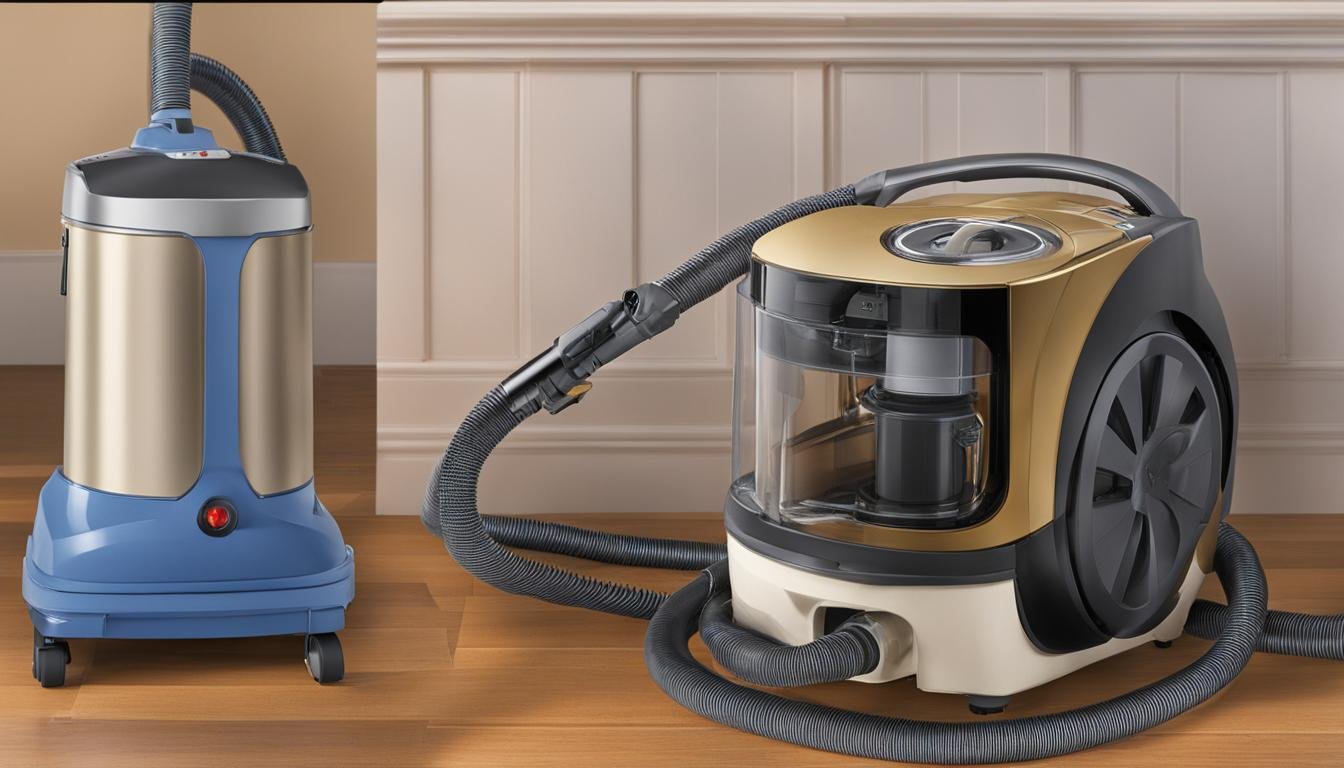When it comes to vacuum cleaners, energy transfer plays a crucial role in their functionality. These essential household appliances rely on the conversion and transfer of energy to effectively clean our homes. Let’s explore the types of energy involved and how they are converted in vacuum cleaners.
A vacuum cleaner transfers energy primarily through the process of heat transfer. Heat can be transferred in three different modes: conduction, convection, and radiation. In a vacuum cleaner, the primary mode of heat transfer is radiation. This means that heat energy is transferred through electromagnetic waves, without the need for a medium.
Understanding the different types of energy involved in vacuum cleaners can give us a better insight into their functionality and efficiency. Let’s delve deeper into the energy usage and conversion in these essential home appliances.
Key Takeaways:
- Vacuum cleaners transfer energy through various processes, with one key method being heat transfer.
- Heat transfer in vacuum cleaners primarily occurs through radiation, which does not require a medium.
- Different appliances in our homes convert electrical energy into various forms, such as kinetic energy in vacuum cleaners.
- Considering energy efficiency when purchasing a vacuum cleaner can help reduce energy consumption and electricity costs.
- Understanding energy transfer in household appliances can guide us in making informed choices about energy usage in our homes.
Energy Usage and Efficiency of Vacuum Cleaners
Vacuum cleaners play a crucial role in keeping our homes clean and dust-free. However, have you ever wondered how much energy these household appliances consume? Understanding their energy usage and efficiency is important not only for our wallets but also for the environment.
A regular-sized household vacuum cleaner typically uses between 500 and 3000 watts of energy. The energy consumption depends on various factors, including the model, design, and features. However, in recent years, manufacturers have been focusing on developing more energy-efficient vacuum cleaners.
Energy-efficient vacuum cleaners are designed to minimize energy consumption while maintaining effective cleaning performance. These models typically consume less power, ranging from 600 to 800 watts. This reduction in energy usage can lead to significant savings in electricity costs over time, especially if you use your vacuum cleaner frequently.
When purchasing a vacuum cleaner, it is important to consider its energy efficiency. Look for models that have earned the ENERGY STAR® certification, as they meet strict energy efficiency guidelines established by the U.S. Environmental Protection Agency. Energy-efficient vacuum cleaners not only help minimize environmental impact but also contribute to reducing greenhouse gas emissions.
Investing in an energy-efficient vacuum cleaner not only benefits your budget but also promotes sustainable living. By choosing a vacuum cleaner with lower energy consumption, you can reduce your carbon footprint and contribute to a greener future.
By making informed decisions about the energy usage and efficiency of vacuum cleaners, we can create a cleaner and more sustainable environment for ourselves and future generations.
Understanding Energy Transfer in Household Appliances
Vacuums are just one example of household appliances that transfer energy. In general, various types of energy can be transferred in household appliances. For example, electrical energy is converted into kinetic energy in a vacuum cleaner, allowing it to suck up dust and debris. The electrical energy powers the motor, which then converts the electrical energy into the mechanical energy needed to create suction.
However, energy transfer in home appliances is not limited to vacuums. Other appliances also convert electrical energy into different forms of energy. For instance, an oven or toaster converts electrical energy into thermal energy to cook food, while a lamp or TV converts electrical energy into light energy to provide illumination or display images. Additionally, appliances like speakers convert electrical energy into sound energy, allowing us to enjoy music or hear dialogue from a TV show.
Understanding how energy is transferred and converted in different household appliances is essential for making informed choices about energy usage and efficiency in our homes. By selecting appliances that are energy-efficient and designed to minimize energy consumption, we can reduce our environmental impact and save on electricity costs. So, next time you use your vacuum cleaner or any other household appliance, remember the fascinating process of energy transfer happening behind the scenes.
FAQ
What types of energy does a vacuum cleaner transfer?
Vacuum cleaners transfer energy through various processes, primarily through the conversion of electrical energy into kinetic energy. Other types of energy involved in the operation of a vacuum cleaner include thermal energy and sound energy.
How does a vacuum cleaner use energy?
A vacuum cleaner uses energy by converting electrical energy from the power source into kinetic energy that powers the suction and movement of the vacuum. It also converts some electrical energy into thermal energy due to the heat generated during operation.
What is the energy efficiency of vacuum cleaners?
The energy efficiency of vacuum cleaners varies depending on the model and design. More energy-efficient models consume less power, typically ranging from 600 to 800 watts, compared to regular-sized household vacuum cleaners that can use between 500 and 3000 watts.
How does energy transfer occur in other home appliances?
Energy transfer in household appliances can occur in various ways. For example, ovens and toasters convert electrical energy into thermal energy for cooking, lamps and TVs convert electrical energy into light energy, and speakers convert electrical energy into sound energy. Understanding these energy transfers can help optimize energy usage and efficiency in the home.





Leave a Reply